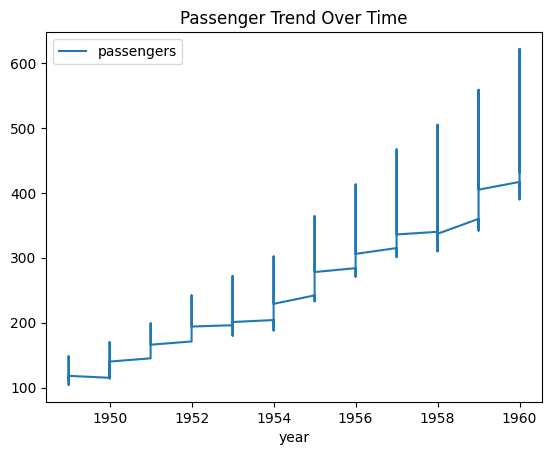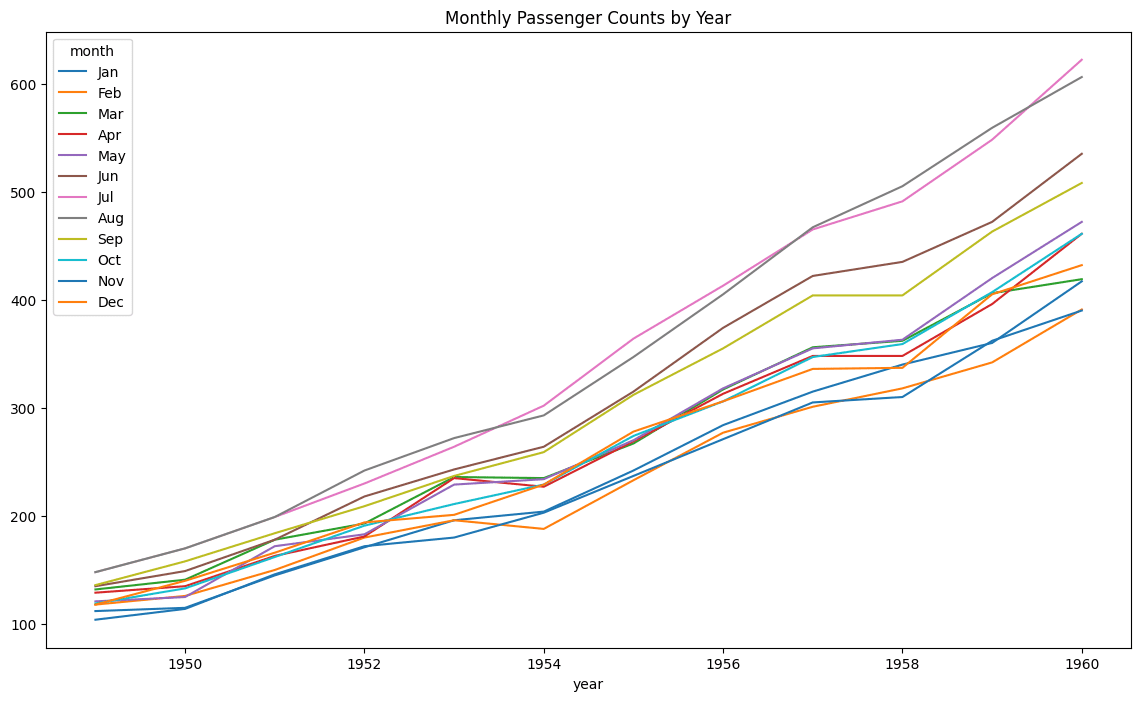Image by Author | Ideogram
Ever found yourself trying to wrap your head around a new dataset, wishing there was a faster way to make sense of it all? You’re not alone.
As data professionals, we’ve all been there — staring at a dataset, knowing there’s helpful info somewhere in it. That’s where Pandas one-liners come in.
In this article, we’ll go voer 10 useful Pandas one-liners for exploratory data analysis. We’ll use the Seaborn flights dataset as an example.
🔗 Link to the Google Colab notebook.
1. Getting a Quick Dataset Overview
This simple command gives you a comprehensive overview of your dataset — the number of rows and columns, column names, data types, and non-null counts. It helps you immediately identify potential missing values and understand the structure of your data.
Output:
RangeIndex: 144 entries, 0 to 143
Data columns (total 3 columns):
# Column Non-Null Count Dtype
--- ------ -------------- -----
0 year 144 non-null int64
1 month 144 non-null category
2 passengers 144 non-null int64
dtypes: category(1), int64(2)
memory usage: 2.9 KB
2. Checking for Missing Values
Missing data can significantly impact your analysis. This one-liner gives you a column-wise count of missing values, helping you decide how to handle them.
Output:
0
year 0
month 0
passengers 0
dtype: int64
Great! No missing values in this dataset.
3. Generating Statistical Summaries
This provides comprehensive statistical summaries for all columns, including count, mean, standard deviation, min, max, and quartiles for numerical data, plus useful information for categorical columns.
Output:
year passengers
count 144.000000 144.000000
mean 1954.500000 280.298611
std 3.464102 119.966317
min 1949.000000 104.000000
25% 1951.750000 180.000000
50% 1954.500000 265.500000
75% 1957.250000 360.500000
max 1960.000000 622.000000
4. Identifying Unique Values in Categorical Columns
Understanding the cardinality of categorical variables is essential. This one-liner returns a dictionary with the count of unique values for each categorical column.
col: flights[col].nunique() for col in flights.select_dtypes(include=['category', 'object']).columns
Output:
We can see there are 12 unique months, as expected.
5. Finding Correlations Between Variables
This calculates the correlation matrix for all numerical variables, helping you identify relationships between variables.
6. Calculating Group-wise Aggregations
This one-liner groups data by a categorical variable and computes multiple statistics in one go.
flights.groupby('month')['passengers'].agg(['mean', 'min', 'max', 'std'])
Output:
mean min max std
month
Jan 241.750000 112 417 101.032960
Feb 235.000000 118 391 89.619397
Mar 270.166667 132 419 100.559194
Apr 267.083333 129 461 107.374839
May 271.833333 121 472 114.739890
Jun 311.666667 135 535 134.219856
Jul 351.333333 148 622 156.827255
Aug 351.083333 148 606 155.783333
Sep 302.416667 136 508 123.954140
Oct 266.583333 119 461 110.744964
Nov 232.833333 104 390 95.185783
Dec 261.833333 118 432 103.093808
We can see the seasonal patterns in passenger numbers, with average values across different months.
7. Identifying Outliers with IQR Method
This one-liner identifies outliers using the Interquartile Range (IQR) method. Values below Q1 – 1.5*IQR or above Q3 + 1.5*IQR are considered outliers.
Q1, Q3 = flights['passengers'].quantile(0.25), flights['passengers'].quantile(0.75); flights[(flights['passengers'] Q3 + 1.5 * (Q3 - Q1))]
You’ll see that there aren’t any outliers.
8. Creating a Time Series Trend Plot
Visualizing trends over time is crucial for time series data. This one-liner creates a plot showing how passenger numbers changed over years.
flights.plot(x='year', y='passengers', figsize=(12, 6), title="Passenger Trend Over Time")
The output is a line plot showing the trend of passengers over time.

9. Calculating Period-over-Period Changes
This one-liner calculates the percentage change from the previous period, allowing you to understand growth rates.
flights.assign(pct_change=flights['passengers'].pct_change() * 100)
Output:
year month passengers pct_change
0 1949 Jan 112 NaN
1 1949 Feb 118 5.357143
2 1949 Mar 132 11.864407
3 1949 Apr 129 -2.272727
4 1949 May 121 -6.201550
... ... ... ... ...
139 1960 Aug 606 -2.572347
140 1960 Sep 508 -16.171617
141 1960 Oct 461 -9.251969
142 1960 Nov 390 -15.401302
143 1960 Dec 432 10.769231
144 rows × 4 columns
This shows the month-over-month percentage change in passenger numbers.
10. Creating a Seasonal Decomposition
This one-liner transforms the data into a matrix format with years as rows and months as columns, then creates a visualization showing seasonal patterns across years.
flights.pivot(index='year', columns="month", values="passengers").plot(figsize=(14, 8), title="Monthly Passenger Counts by Year")

This gives a line plot showing passenger counts by month for each year, revealing seasonal patterns.
Wrapping Up
These 10 pandas one-liners show how you can use pandas for exploratory data analysis. By combining these techniques, you can quickly gain insights into any dataset’s structure, contents, and patterns.
Happy data analysis!
Bala Priya C is a developer and technical writer from India. She likes working at the intersection of math, programming, data science, and content creation. Her areas of interest and expertise include DevOps, data science, and natural language processing. She enjoys reading, writing, coding, and coffee! Currently, she’s working on learning and sharing her knowledge with the developer community by authoring tutorials, how-to guides, opinion pieces, and more. Bala also creates engaging resource overviews and coding tutorials.
